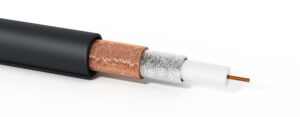It’s Probably the Cable!
In the pH business, we quickly blame most measurement performance issues on the sensor. The sensor is the primary measurement element of the loop and is in contact with the process. So, it must be the source of the problem, right?
In my experience, something more rudimentary causes most pH problems. Unfortunately, operators often overlook these two factors – sensor connections and cables.
Coaxial Cables for pH Sensors
Most pH sensors in the field have coaxial cables that carry the signal. They are analog and communicate with a transmitter via a voltage change in the millivolt range.
Coaxial cable construction has precise, constant conductor spacing. This spacing is required for the cable to function efficiently as a transmission line. Therefore, any damage or electrical interference to coaxial cables will cause the sensors to appear to drift or prematurely fail.

Cable Damages
Here are cable damage examples I’ve seen firsthand that have caused signal drift and sensor failure:
-
- Physical Damage
Rough or improper handling is the most common type of damage. Above all, be careful of the bend radius, and don’t crimp a coax cable! - Water Damage
Small nicks in the outer sheath or submersion of a coaxial cable can allow water to enter. Consequently, waterlogged cables produce altered electrical characteristics. - Heat Damage
Polyethylene and polyvinyl chloride are insulators in coax cables. These plastics have relatively low melting points and can also soften at temperatures as low as 150ºF. As a result, the center conductor can shift position when the insulator softens. This impacts the efficiency and accuracy of the measurement. If the center conductor and shield touch, the signal will not make it past that point.
- Physical Damage
Types of Electrical Interference
Electrical interference also causes drift or failure for a sensor using a coaxial cable:
-
- Signal Leakage
The passage of electromagnetic fields through the coax cable shield can occur in both directions. Ingress is the passage of an outside signal into the cable, resulting in signal noise and disruption. - Ground Loops
A continuous current, even if small, along the imperfect shield of a coaxial cable can cause interference. - Noise
External fields create a voltage across the outer conductor’s inductance between the sensor and transmitter. Because the outer conductor carries the reference potential for the signal on the inner conductor, the transmitter will measure the wrong voltage, thereby providing an inaccurate measurement.
- Signal Leakage
Coaxial cable is a significant contributor to pH measurement drift and premature failure. So why are so many manufacturers using it when there are other options?!
The Alternative: 4-Conductor Digital Memosens® Cables
By introducing digital sensing cable technology and inductive sensor fittings, there is no longer a need to use coaxial cable and conductive connections. As a result, Memosens cables change the status quo in analytical measurement by removing drift from analytical measurements.
Memosens technology – released in February 2009, uses a 4-conductor, shielded cable that provides power to pH/ORP, oxygen, and conductivity sensors. Since Memosens sensors are digital, the technology also transmits process information and sensor diagnostics to your transmitter.

Why does this matter?
- You do regular PMs for calibration of your pH sensors because they frequently drift.
- You’re spending a lot of money replacing pH sensors.
- Every time you replace a sensor, it’s an arduous process.
Memosens Cables Alleviate Each of These Pains
Frequent Calibration
Analog sensors use a coaxial cable to send a voltage signal to the transmitter. However, coaxial cable can introduce drift through signal leakage, ground loops, and noise. They are also highly susceptible to physical, water, and heat damage.
Solution: Memosens sensors use a standard 4-conductor cable to send a digital signal to the transmitter. There is no coaxial cable. You can cut, splice, and extend Memosens cables for long distances. Furthermore, you can completely submerge the cable. As a result, there will be ZERO drift from the cable, meaning fewer, less frequent calibrations of Memosens sensors. This feature saves technicians time and aggravation.
Spending Too Much Money Replacing Sensors:
You can only calibrate a sensor so many times before it is no longer trusted. Unfortunately, the many limitations of coaxial cable have caused the early demise of tens of thousands of sensors.
Solution: Memosens sensor cables are not susceptible to these limitations. Diagnostics provided from the sensor confirm cable and sensor performance. Additionally, you can check and calibrate Memosens sensors offline. This feature quickly identifies the malfunctioning component. These advantages mean you will likely replace fewer sensors.
Replacing Sensors is a Painful Process:
With some analog and digital sensors, you must go to the transmitter, remove the wires from the terminal block, and pull the cable through your fitting, cable tray, and/or conduit. This process takes time and can also be cumbersome.
Solution: Memosens cable connections have a submersible, quick disconnect for the sensor. Therefore, you no longer need to go to the transmitter to remove wires and pull cables. Instead, simply, disconnect and replace. As a result, field maintenance time is drastically reduced.
In short, sometimes the solution is simple; it probably is the cable!
